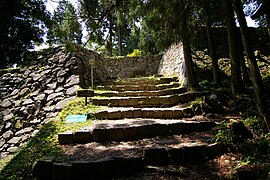Iwamura Castle
| Iwamura Castle | ||
|---|---|---|
|
View from the castle into the valley |
||
| Creation time : | 12th Century | |
| Castle type : | Yamajiro (mountain castle) | |
| Conservation status: | Walls preserved | |
| Place: | Ena | |
| Geographical location | 35 ° 21 '35.8 " N , 137 ° 27' 3.7" E | |
| Height: | 721 m TP | |
|
|
||
The Castle Iwamura ( Japanese 岩村城 , Iwamura-jō ) in Ena one of the few Japanese mountain castles, which were used even after the 1600th
history
Rule of the Tōyama and the Sengoku period
The castle is said to have been built by the higher samurai Katō Kagekado in 1185. His son Kagetomo was the first to use the name Tōyama. The Tōyama remained the lords of the castle for almost four hundred years.
During the Sengoku period , the castle was caught in the fighting between Takeda Shingen and Oda Nobunaga . The head of the house, Tōyama Kagetō, had joined Nobunaga and married his aunt, Watanabe Misako. From 1570, Akiyama Nobutomo , a general of Takeda Shingen, tried to conquer the castle. When Kageto died in 1573, Misako took over the management of the family in place of the eight-year-old adoptive son (Nobunaga's fifth son) and continued to defend the family. Negotiations finally came about, and Nobutomo became lord of the castle in 1573 and married Kagetō's widow. But he was attacked by Oda Nobutada in 1575 and lost the castle. As a result, he, his wife and his followers had to lose their lives.
In 1575 Kawajiri Shizuyoshi became lord of the castle for seven years with an income of 50,000 koku , until he was replaced by the young Mori Rammaru in 1582 . After Rammaru died in the Honnōji incident that same year , his siblings Nagayoshi and Tadamasa became lords of the castle and modernized the castle. The Mori was followed by Tamaru Tomotada, who, however, fell out of favor after a year because of his behavior in the Battle of Sekigahara near Tokugawa Ieyasu .
Edo period
After Tokugawa Ieyasu came to power in 1601, the Ogyū-Matsudaira received the castle with an income of 20,000 koku until they went to Hamamatsu in 1638 and the Niwa took over the castle. In 1702 the Ogyū returned in a change of country and remained lords of the castle until the Meiji restoration . Then they carried the title Vice Count.
The castle complex
With an altitude of 721 m, Iwamura is the highest mountain castle of the Edo period. The Hommaru (see 1 in the map of the castle) at the highest point is represented by Ni-no-maru (2), Higashi-guruwa (3), Obi-guruwa (4), De-maru (5), Hachiman-guruwa ( 6) surrounded. There were two two-story watchtowers in the Hommaru, but there was no castle tower (tenshu). In its place, a three-story watchtower at the main gate (Ōte-mon, 7) took over this function.
Ogyū Ienori, who took over the castle in 1601, built a residence below the north-western slope, as well as quarters for his followers, so that a castle town was created there.
When it was taken over in 1702, the following was noted: The outline of the castle is 1255 m, there are 11 watchtowers (including a three-story and a one-story), 8 larger and smaller overbuilt wall sections (tamon) and 17 larger and smaller gates.
After the castle was abandoned in 1873, all the buildings were demolished, so that only stone walls remain today. The residence below escaped this fate, but burned down in 1881. The residence was partially rebuilt in 1990, as well as a gate and the drum tower.
photos
Individual evidence
literature
- Owada, Yasutsune: Iwamura-jo in: Miura, Masayuki (ed.): Shiro to jinya. Tokoku-hen. Gakken, 2006, ISBN 978-4-05-604378-5 .






